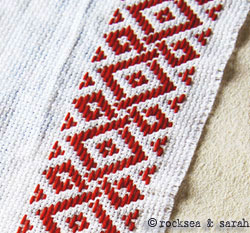 |
| Embroidery sample: Pattern Darning |
About Pattern darning
The darning stitch is used in an embroidery technique called ‘Pattern darning’. Using rows of straight running stitches of long and short length, patterns are created. This embroidery type is one of the oldest and has been found to be used across cultures from Egypt, Iceland, Japan, India, and the Mediterranean regions. It is a very easy technique to follow, especially if done over an even weave cloth.
The visual effect of pattern darning is that of satin stitch, but it differs in its stitch technique. While satin stitch concentrates on each motif or pattern at a time, pattern darning involves carrying the thread for the entire width or length of the design at a time. The lessons will make this point clear.
History
In Egypt, some 12th-century textile examples prove the use of such embroidery. The Mamluk period (1250-1517) shows the extensive use of pattern darning over the clothing of various sorts. Silk was a more popularly used thread than cotton or linen.
In Iceland, pattern darning is known as ‘Sakkaglit’. It was used to work on many church embroideries and have been used during the early 14th century. Textiles from the 15th century to the 17th depict the use of this embroidery style as well. Wool was the preferred thread over linen.
In Japan, this embroidery style is known as ‘Kogin’. It was found to be done with white cotton thread over indigo hemp or linen fabric. Kogin originated during the feudal period of the 16th to 19th century. Kogin is used even today for embroidering quilts.
Interestingly, a 15th-century towel from Germany depicts the use of pattern darning as an effort to imitate the popular Italian Perugian towels where the patterns were woven into the towel. The pattern on the German towel was similar to the Egyptian pattern darning patterns.
Patterns used
The patterns used are geometrical patterns. Yet, there have been examples where stylized and geometrically inclined figures of birds, animals, and humans have been used.
Stitch used
Darning stitch
Next, go to the tutorials of Pattern Darning:
Reference:
Carol Hanson,www.dragonbear.com
Filum Aureum, Newsletter of the Needleworkers Guild




 Sarah has been researching and sharing hand embroidery lessons for over 17 years, making it accessible to everyone around the globe.
Sarah has been researching and sharing hand embroidery lessons for over 17 years, making it accessible to everyone around the globe.



I tried your 6B pencil method. Did a direct tracing as my fabric was white cotton, and made my graph drawing dark. Sharing my work started on a blouse Sarah. Thank you for inspiring me.



Mazahua textiles from the Valle de los Bravos from the mountains Mexico state these from San Simion de la Laguna
Wow, this is beautiful, Patricia! This is definitely inspiring. Thank you for sharing.
I would love to speak with you more regarding the embroidery stitches that I have found among the Huichol. You have noted a Cora stitch from the peoples that live adjacent to the Huichol but this is not the Cora stitch.

Images are of top & bottom (2) then photos with & without flash (3)
This is exactly like Croatian embroidery. This particular kind of embroidery is popular in southern Dalmatia, in and near Dubrovnik.
Wow, thank you for the information, Ann. ❣️ This pattern is popular in the Japanese pattern darning method called Kogin.
Excellent Blog. I think very useful for all people. Keep up the great posts!
Vector Format
Saw the different samples . Got inspired so much could not resist uploading my work. Its done using stem and chain stitch.
In Finland it’s called “virvittäin ompelu”
🙂
hehe. you are always wonderful in making such accessories for me! love the lunch sack you made :*